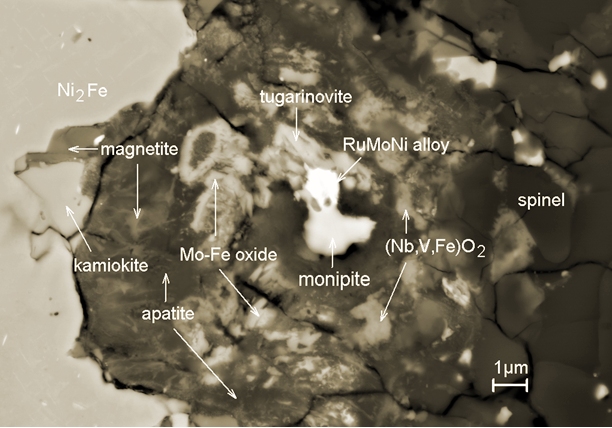Monipite, MoNiP,
a new phosphide mineral in
a Ca-Al-rich inclusion from the Allende meteorite
Chi
Ma, John R. Beckett, George R. Rossman
Division
of Geological and Planetary Sciences
California
Institute of Technology
Pasadena,
CA 91125, USA
abstract
Monipite
(IMA
2007-033), MoNiP, is a new phosphide mineral that occurs as one 1 × 2 mm crystal in a Type B1 Ca-Al-rich
inclusion
(CAI) ACM-2 from the Allende CV3
carbonaceous chondrite. It has a  Fe2P type
structure with a =5.861 Å, c =
3.704 Å, V= 110.19 Å3,
and Z = 3. The calculated density using our measured
composition is 8.27 g/cm3, making monipite the densest known
mineral
phosphide. Monipite probably either
crystallized
from an immiscible P-rich melt that had exsolved from an Fe-Ni-enriched
alloy
melt that formed during melting of the host CAI or it exsolved from a
solidified alloy. Most of the original
phosphide in the type occurrence was later altered to apatite and
Mo-oxides,
leaving only a small residual grain. Monipite occurs within an opaque
assemblage included in melilite that contains kamiokite (Fe2Mo3O8),
tugarinovite (MoO2), and
a Nb-rich
oxide ((Nb,V,Fe)O2), none of which has previously been
reported in
meteorites, together with apatite, Ni2Fe metal, and vanadian
magnetite.
Fe2P type
structure with a =5.861 Å, c =
3.704 Å, V= 110.19 Å3,
and Z = 3. The calculated density using our measured
composition is 8.27 g/cm3, making monipite the densest known
mineral
phosphide. Monipite probably either
crystallized
from an immiscible P-rich melt that had exsolved from an Fe-Ni-enriched
alloy
melt that formed during melting of the host CAI or it exsolved from a
solidified alloy. Most of the original
phosphide in the type occurrence was later altered to apatite and
Mo-oxides,
leaving only a small residual grain. Monipite occurs within an opaque
assemblage included in melilite that contains kamiokite (Fe2Mo3O8),
tugarinovite (MoO2), and
a Nb-rich
oxide ((Nb,V,Fe)O2), none of which has previously been
reported in
meteorites, together with apatite, Ni2Fe metal, and vanadian
magnetite.

Back
scattered electron image showing monipite and its associated minerals.
Chi Ma SEM image.
 Fe2P type
structure with a =5.861 Å, c =
3.704 Å, V= 110.19 Å3,
and Z = 3. The calculated density using our measured
composition is 8.27 g/cm3, making monipite the densest known
mineral
phosphide. Monipite probably either
crystallized
from an immiscible P-rich melt that had exsolved from an Fe-Ni-enriched
alloy
melt that formed during melting of the host CAI or it exsolved from a
solidified alloy. Most of the original
phosphide in the type occurrence was later altered to apatite and
Mo-oxides,
leaving only a small residual grain. Monipite occurs within an opaque
assemblage included in melilite that contains kamiokite (Fe2Mo3O8),
tugarinovite (MoO2), and
a Nb-rich
oxide ((Nb,V,Fe)O2), none of which has previously been
reported in
meteorites, together with apatite, Ni2Fe metal, and vanadian
magnetite.
Fe2P type
structure with a =5.861 Å, c =
3.704 Å, V= 110.19 Å3,
and Z = 3. The calculated density using our measured
composition is 8.27 g/cm3, making monipite the densest known
mineral
phosphide. Monipite probably either
crystallized
from an immiscible P-rich melt that had exsolved from an Fe-Ni-enriched
alloy
melt that formed during melting of the host CAI or it exsolved from a
solidified alloy. Most of the original
phosphide in the type occurrence was later altered to apatite and
Mo-oxides,
leaving only a small residual grain. Monipite occurs within an opaque
assemblage included in melilite that contains kamiokite (Fe2Mo3O8),
tugarinovite (MoO2), and
a Nb-rich
oxide ((Nb,V,Fe)O2), none of which has previously been
reported in
meteorites, together with apatite, Ni2Fe metal, and vanadian
magnetite.